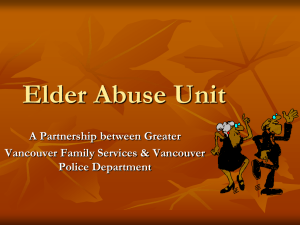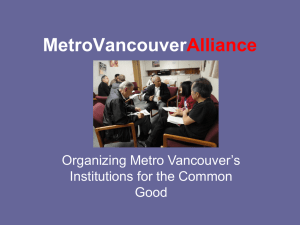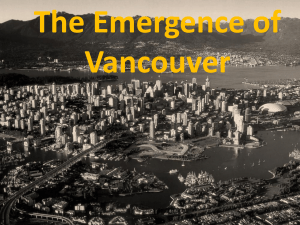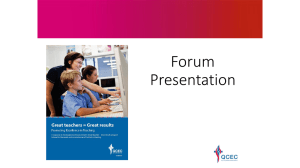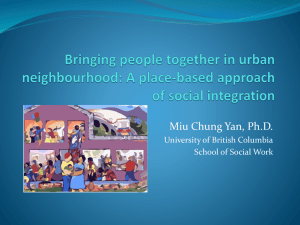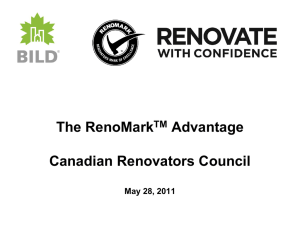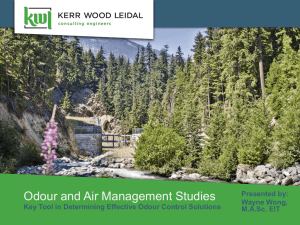Indicative Design - District of West Vancouver
advertisement
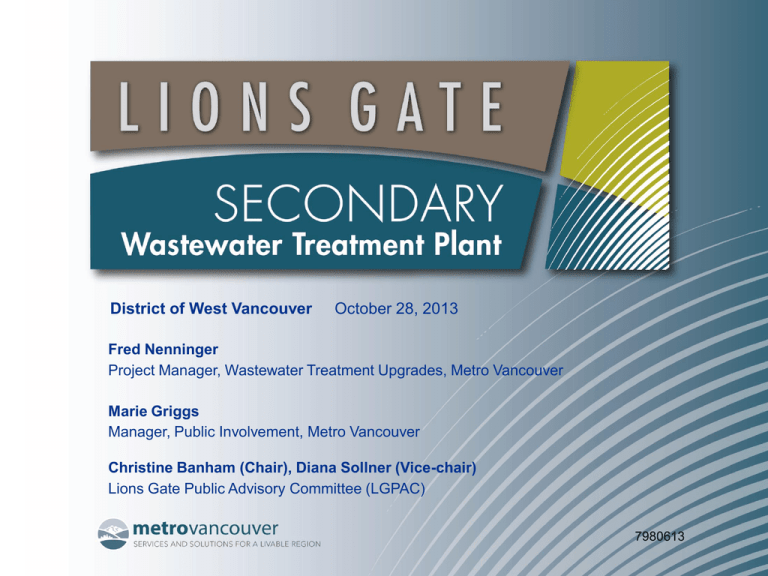
District of West Vancouver October 28, 2013 Fred Nenninger Project Manager, Wastewater Treatment Upgrades, Metro Vancouver Marie Griggs Manager, Public Involvement, Metro Vancouver Christine Banham (Chair), Diana Sollner (Vice-chair) Lions Gate Public Advisory Committee (LGPAC) 7980613 Fred Nenninger Project Manager, Wastewater Treatment Upgrades Metro Vancouver District of West Vancouver October 28, 2013 New Location Existing Treatment Plant Site Existing Outfall 3 Key Project Objectives Secondary Wastewater Treatment Sustainability Environmental, Social, Economic Integrated Resource Recovery Community Integration 4 Overall Project Timeline Design & Construction 2014 - 2020 Decommission the Old Plant 2021 Project Definition 2012 - 2013 5 Approach 6 Indicative Design • Secondary Treatment for 2 x Average Dry Weather Flow • 320 MLD wet weather capacity • Biogas production and energy recovery • Low grade effluent heat recovery • Reclaimed water recovery • Phosphorus recovery – future potential 7 Plant Layout – Indicative Design 8 Integrated Resource Recovery District Energy Space for Future Struvite Recovery Reclaimed Water Biogas Utilization 9 Biotowers Activated Carbon 10 11 12 13 14 15 1637 17 18 19 20 21 22 Funding Programs Building Canada P3 Canada Status •Announced in 2013 •Application process to be finalized Receiving applications in 2014 Procurement Options P3 screening business case required by provincial and federal governments Must be a P3 for eligibility 23 Compared Three Project Delivery Alternatives Design-Bid Build (DBB) Design-Build finance (DBf) Design-BuildFinance-OperateMaintain(DBFOM) Traditional contracting approach Design-build with an extended warranty period A full public-private partnership (P3) 24 Design and Construction Delivery Subcommittee to review options and business case and recommend the procurement approach for the Design and Construction Phase. 25 Questions? Cover slide 26 Engagement and Consultation Marie Griggs Manager, Public Involvement, Metro Vancouver District of West Vancouver October 28, 2013 Target Audiences Public Government Agencies All Project Phases First Nations Metro Vancouver Members Advisory Committees 28 Public Input Norgate community and other North Shore residents most active participants: 86% April public meeting 75% October public meeting Regional interests focused primarily on costsharing and overall project costs. 29 Engagement and Consultation Events 24 Public Events 7 Lions Gate Public Advisory Committee (LGPAC) meetings 2 Community Resource Forum (CRF) meetings 6 Community workshops (CRF & LGPAC) 3 Norgate residents' meetings and open houses 2 Norgate business meetings 1 Norgate block party 1 U.S. study tour & 1 local plant tour 2 Public meetings 71 Intergovernmental Meetings 30 Key Public Issues Odour Community Amenities Environmental Impacts & Longterm Planning Noise Traffic Impacts Cost Air Quality Aesthetics Integrated Resource Recovery Educational Opportunities Construction Impacts 31 Indicative Design: Addressing Public Input 32 Public Meeting Results Does the Indicative Design respond to community values? Does the Indicative Design address potential community impacts? 33 Next Steps • Indicative Design and Consultation Reports: November 7 Utilities Committee Meeting • Utilities Committee Recommendations: November 15 MV Board Meeting • Board Subcommittee on Delivery and Construction: 2014 • Consultation on Design and Construction: 2014 - 2020 34 Community Values and Interests for Design Christine Banham (Chair) and Diana Sollner (Vice-chair) Lions Gate Public Advisory Committee District of West Vancouver October 28, 2013 LGPAC Mandate • Provide advice to Metro Vancouver during the Project Definition Phase on the effects on North Shore communities of the planning and construction of the treatment plant • Membership: 11 Primary Members; 8 Alternates − Norgate Community − Environment − Business − Non-affiliated citizens • 11 meetings and workshops from June 2012 to October 2013 • Washington State study tour of 4 wastewater treatment plants 36 LGPAC Key Issues, Values and Priorities Five main themes identified and explored during the Project Definition Phase: 1. Community Impacts 2. Community Integration 3. Environment 4. Economics 5. Education 37 1. Community Concerns Odour • Odour control is a major priority for the community • Washington State study tour showed technology can prevent odour • A ‘no-odour’ standard is mandatory • LGPAC supports the Indicative Design that provides assurance of no odour under normal operations Emissions • Exhaust from co-generation and flaring of excess biogas can impact air quality • LGPAC supports Metro Vancouver’s commitment to monitoring air quality and recommends air quality monitoring in nearby residential areas 38 Community Concerns cont’d Noise • LGPAC supports the indicative design (building siting and massing) that will help reduce noise from the industrial area into the community • LGPAC recommends that concrete surfaces be treated to mitigate sound reflection Truck traffic • LGPAC supports Metro Vancouver’s commitment to restrict truck traffic to day time hours only Construction • Construction plans have not been discussed in the Project Definition phase • LGPAC recommends that engagement continue to address construction planning and implementation 39 2. Community Integration – LGPAC Priorities Aesthetic design • Height, massing, landscaping, water features and public spaces are positive attributes • Additional consideration of building treatment required to improve aesthetics Public access • LGPAC supports public access and use for education, compatible activities (e.g., Research Centre of Excellence, public viewing, use of roof space) Revenue generation • Most LGPAC members support consideration of revenue generation activities, but the priority must remain for wastewater treatment 40 3. Environment – LGPAC Priorities LGPAC supports the Indicative Design that provides for secondary treatment allowing for: • Future higher level of treatment if required • On-site digestion to reduce the mass of biosolids • Proactive public education and source control to reduce contaminants • Air emission containment and monitoring • Consideration of shoreline habitat enhancement, subject to cost • Energy efficient technologies where practical and cost efficient • Plant design that addresses risk of sea level rise and catastrophic events 41 4. Economics LGPAC members: • Are strongly concerned about ratepayer impacts • Question the financial model assumptions (discount rate, amortization) as they may differ from market-based modeling • Most LGPAC members supports market-based financial modeling to allocate costs to ratepayers (1 member disagrees with this approach) LGPAC supports pursuing all federal and provincial funding options Most LGPAC members support considering a P3 delivery model, while some feel more study on delivery models is still needed. 42 5. Education LGPAC members support proactive public education for household source control and water use: • Learning modules for schools • Homeowner education and awareness of disposing of chemicals • Treatment plant tours • On-line engagement Education is essential to: • Reduce contaminants into the waste stream • Improve the environment • Potentially save taxpayers’ money 43 Project Definition to Final Design LGPAC generally supports the Indicative Design as proposed by Metro Vancouver in the Project Definition phase In consultation with the community, the Final Design should address in more detail: • Odour control technology to achieve zero impact on the community • Procurement delivery model • Construction plans and impact mitigation • Fair cost allocation to taxpayers • Proactive public education program 44 Conclusion LGPAC members: • Feel that the concerns of the local community and the broader community have been heard • Agree that the Indicative Design has addressed the issues that matter to our community, recognizing more work will be done in the final design phase • Support Metro Vancouver continuing with community engagement during the next phase of the project LGPAC commends Metro Vancouver on this innovative and interactive community engagement process. 45
